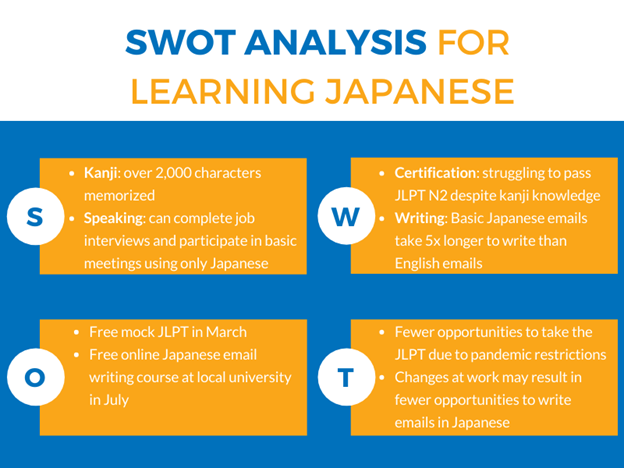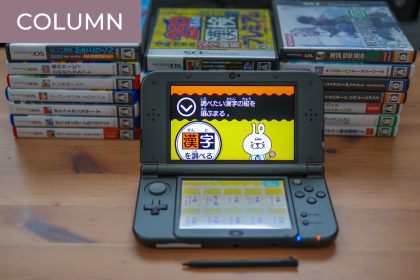Long-time Kokoro Media readers know that I like to apply various frameworks to the process of studying Japanese. I especially enjoy importing concepts from the business world to do this, and in this article, I’ll explain how you can apply the SWOT framework to your Japanese studies. Read on to learn what a SWOT analysis is, the purpose of doing one, and how you can apply this time-tested corporate strategy tool to your quest to master Japanese.
What is a SWOT Analysis?

A business-school favorite, the SWOT framework analyzes an organization’s strengths, weaknesses, opportunities, and threats. Strengths and weaknesses are internal factors while opportunities and threats are external ones. The goal of conducting a SWOT analysis is to identify opportunities for improvement. That’s why this framework is also a great personal development tool, be it for overall personal growth or for individual aspects of your life, such as language learning.
Why Should You Conduct a SWOT Analysis?
Be it in business or life in general, we can’t make progress unless we fully grasp our current situation. Conducting a SWOT analysis creates a 360-degree picture of where we stand, including positive and negative elements, so that we can make an informed decision on how to work toward improvement. In business as well as language learning, randomly trying ideas to see what works will rapidly deplete your most valuable resources: time and money. Instead, turn your learning process into science by establishing a framework and a plan. This is where the SWOT analysis comes in.
How to Conduct a SWOT Analysis for Learning Japanese
Internal Factors
The first half of a SWOT analysis is about examining internal factors that you can influence directly. First, explore your strengths. To do so, consider the following question: what do you do well?
Does grammar come easy to you? Have you mastered all your kanji flashcards? Perhaps you’re an excellent test taker with a great JLPT score. When noting your strengths, back them up with quantitative data (number of flashcards mastered, test scores, etc.).
Next, take a hard look at your weaknesses. Consider the following questions:
- In what aspects of Japanese are you underperforming?
- Where do you need to improve?
Perhaps you’re struggling with the JLPT or having trouble memorizing intermediate-level kanji. Maybe you freeze up when it’s time to speak Japanese in real-world situations. Again, try to quantify this or note any anecdotes that highlight your weaknesses.
External Factors
Now it’s time to focus your attention on external factors in the form of opportunities and threats to your progress. Let’s start with opportunities, which are usually environmental factors that can help you build on your strengths or address your weaknesses.
For example, if you are struggling with speaking Japanese in real-world situations, perhaps there are some upcoming mixers or social events you can add to your calendar that will offer you chances to put your textbook knowledge into practice.
Finally, in a similar fashion, be on the lookout for external threats that have the potential to derail your growth. Threats are intimidating because the worst of them are truly out of your control. For example, heavy-handed immigration policies in response to the global pandemic are a threat to any student who was counting on studying in Japan as part of their Japanese language learning strategy.
Although you can’t control threats like the above, attempting to anticipate them gives you an opportunity to mitigate their effects by creating contingency plans to overcome periods of adversity.

Bringing It All Together

When conducting your SWOT analysis, consider creating a matrix like the one above. Once you’ve carefully crafted a SWOT matrix, you’ll have a clear understanding of your current capabilities and challenges, which will prepare you to harness upcoming opportunities and manage inevitable threats.
From here, the next step is creating an action plan, and for that, consider laying out your SMART goals. Regardless of your unique mix of strengths, weaknesses, opportunities, and threats, studying Japanese based on a reliable framework will guarantee better and faster results.





